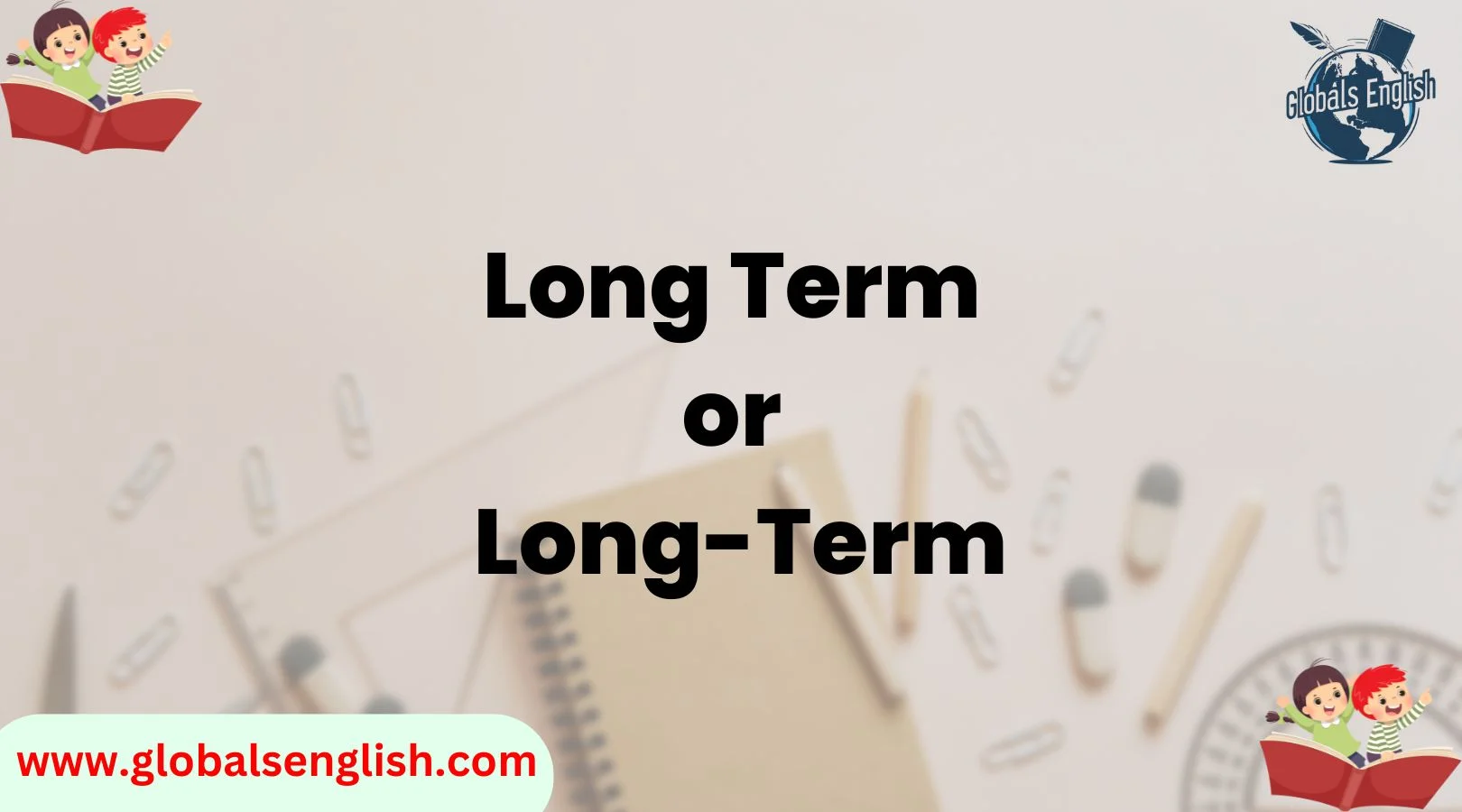Hyphens may seem like small punctuation marks, but they carry significant weight in written English. They can clarify meaning, help sentence flow, and prevent awkward misinterpretations.
One area where this is especially true is with the compound phrase “long term” — is it “long term” or “long-term”? The confusion over whether to use the hyphen often leads to inconsistency in writing, but mastering this can elevate the quality of your content, whether it’s for business, academics, or casual communication.
This post will unravel the mystery behind the hyphen in “long term” vs. “long-term,” offering clear guidance on when to use each, along with examples, rules, and common mistakes.
By the end, you’ll know how to use these terms correctly and improve the clarity of your writing.
The Core Confusion: Long Term vs. Long-Term
Grammatical Breakdown of Each
The difference between long term and long-term may seem subtle, but it’s all about context. The hyphen changes the function of the phrase in the sentence.
- “Long term” (without a hyphen) is used as a noun phrase, typically when referring to time or duration.
- Example: “We are focusing on the long term.”
- Example: “We are focusing on the long term.”
- “Long-term” (with a hyphen) functions as a compound adjective that modifies a noun. This means it describes something that is related to or affects a long period.
- Example: “He made a long-term commitment.”
- Example: “He made a long-term commitment.”
The Role of Hyphens in English Grammar
Hyphens serve a purpose in grammar: they connect words that work together as a single modifier. When the modifier appears before the noun, a hyphen is often required. Without it, the sentence can feel disjointed, and the meaning might become unclear.
For example:
- Correct: “We are looking for a long-term investment.”
- Incorrect: “We are looking for a long term investment.”
The hyphen helps clarify that long-term is a single, unified concept that modifies the noun “investment.”
The Hyphen Rule in Action
Use Hyphen When the Phrase Comes Before a Noun
The general rule is that you should use a hyphen when the phrase is placed before a noun. This applies to all compound adjectives. Here’s how the rule works for “long-term.”
Example Sentences with Hyphen:
- “We need a long-term plan for success.”
- “She committed to a long-term project.”
- “The long-term effects of the policy are still being analyzed.”
In these examples, “long-term” directly describes or modifies the noun, making the hyphen necessary for clarity.
Drop the Hyphen When the Phrase Stands Alone
On the other hand, when the phrase appears after the noun, the hyphen is generally dropped. It becomes a noun phrase rather than an adjective.
Example Sentences Without Hyphen:
- “The focus is on the long term.”
- “We’re thinking about long term goals.”
- “This issue will be resolved in the long term.”
In these instances, “long term” isn’t modifying a noun directly, so no hyphen is required. The phrase functions independently as a noun rather than a compound adjective.
Visual Guide: When to Hyphenate “Long Term”
A visual guide can often help solidify understanding. Below is a simple comparison chart illustrating when to use the hyphen and when to leave it out.
| Sentence Type | Correct Form | Example Sentence |
| Before a Noun (Adjective) | Long-term | “A long-term strategy is essential.” |
| After a Noun (Noun Phrase) | Long term | “We are committed to the long term.” |
| Use in Compound Predicate | Long term | “Our goals will remain long term.” |
This table highlights the practical differences in how “long-term” functions depending on its position in the sentence.
Common Pitfalls Writers Face
Over-Hyphenating Out of Fear
Some writers overuse hyphens out of caution, afraid of making a mistake. This can lead to unnecessary hyphenation, which can make writing appear stiff or overly formal. For example:
- Incorrect: “The company has long-term financial goals.” (Here, the adjective would still work without the hyphen.)
Sometimes the sentence doesn’t need the hyphen, and you may want to reconsider your use of it. Over-hyphenation can interrupt the natural flow of the text and make it harder for readers to understand.
Under-Hyphenating and Losing Clarity
Conversely, under-hyphenation is equally problematic. Writing “long term” as two separate words when it’s functioning as an adjective can confuse your audience.
Without the hyphen, it becomes harder to distinguish whether you are referring to a concept of time or a compound adjective describing a noun.
For example:
- Incorrect: “The company made a long term decision.” (Here, “long term” is modifying the noun “decision” and needs a hyphen.)
- Correct: “The company made a long-term decision.”
In cases like this, the hyphen is essential for keeping the meaning clear.
When In Doubt, Rephrase
A great tip for avoiding hyphenation confusion is to rephrase the sentence. This can often clarify whether a hyphen is necessary.
- Instead of saying, “This is a long-term issue,” you could say, “This issue is long term.”
Rewriting sentences may remove the need for a hyphen or improve readability, especially in cases where the hyphen is unnecessary.
Style Guides: Who Says What?
Associated Press (AP) Stylebook
The AP Stylebook is one of the most widely used guides for journalists and content creators. It advocates for hyphenating compound adjectives before a noun to improve clarity. Thus, the AP recommends using long-term when describing a noun:
- Correct (AP): “This is a long-term solution.”
- Incorrect (AP): “This is a long term solution.”
AP also notes that in phrases like “for the long term,” no hyphen is needed since the phrase is functioning as a noun.
Chicago Manual of Style (CMOS)
CMOS is more lenient than AP, but it generally supports hyphenating compound adjectives. In cases like “long-term,” CMOS recommends the hyphen when used as an adjective but permits flexibility depending on the commonality of the term:
- Correct (CMOS): “We are embarking on a long-term journey.”
- Correct (CMOS): “The project spans a long term.”
Chicago’s rule allows for a slightly more nuanced approach, acknowledging that context matters when deciding on hyphenation.
MLA, APA, and Other Academic Styles
MLA and APA styles typically align with the general rule of using hyphens in compound adjectives before nouns. Both guides emphasize clarity and consistency. Therefore, in academic papers, it’s crucial to follow these established rules:
- Correct (MLA/APA): “This is a long-term study.”
- Incorrect (MLA/APA): “This is a long term study.”
Hyphenation in British vs. American English
Differences in Treatment
While hyphenation rules for “long term” are largely the same in both British and American English, there are some slight differences in preferences for compound terms.
British English tends to use more hyphens, while American English favors cleaner, less-hyphenated structures. Here’s how the two regions might treat the phrase:
- British English: “This is a long-term strategy.”
- American English: “We are looking at long-term options.”
Although both are correct, British English might sometimes opt for hyphenation in more compound words compared to American English, which focuses on simplifying where possible.
Real-World Examples of “Long Term” vs. “Long-Term” in Use
In Business and Marketing
In professional contexts, particularly business and marketing, it’s crucial to get hyphenation right to avoid misinterpretation. The distinction between long-term goals and long term strategies can impact perceptions of a company’s approach to time and planning.
- Business Example (Hyphenated): “We are committed to a long-term partnership.”
- Marketing Example (No Hyphen): “We focus on success in the long term.”
In Finance and Investment
In finance, where precision is key, “long-term” is used to describe investments or plans that span a significant period of time. However, when talking about durations or periods in general, you’ll find that the hyphen is often dropped.
- Correct (Hyphenated): “We are seeking long-term growth in our portfolio.”
- Correct (No Hyphen): “Investing for the long term requires patience.”
In Scientific and Technical Writing
In technical writing, clarity is paramount. “Long-term” is often used to describe effects or processes that unfold over time, while “long term” might be used when referring to a specific period.
- Correct (Hyphenated): “The long-term effects are still being studied.”
- Correct (No Hyphen): “This research will take place over the long term.”
Tools to Help You Get It Right
Grammar and Style Checkers
Tools like Grammarly and Hemingway Editor are invaluable when you’re unsure about hyphen use. These tools check for grammar, readability, and correct punctuation.
- Grammarly will flag unnecessary hyphenation and provide suggestions for better readability.
- Hemingway Editor encourages simplicity, making it easier to avoid over-hyphenating.
Tips and Tricks for Mastering Hyphen Use
Memory Aids and Mnemonics
A simple trick to remember when to use the hyphen: “Before the noun, connect the term with a hyphen. After the noun, let it roam free.”
Editing Like a Pro
When editing, read your sentence out loud. If it sounds natural with a pause between words, the hyphen is likely necessary.
Conclusion
The difference between “long term” and “long-term” may be subtle, but it’s essential for clarity and professionalism in writing. By understanding the rules and applying them consistently, you’ll be able to use these phrases correctly in your own work. Whether you’re writing for business, academic purposes, or casual communication, following these simple guidelines will make your writing more precise, readable, and impactful.
FAQs: Long Term vs. Long-Term
1. What is the difference between “long term” and “long-term”?
The difference lies in the use of the hyphen. “Long term” (without the hyphen) is a noun phrase that refers to a period of time. It is used when the phrase stands alone or after a noun. “Long-term” (with the hyphen) is a compound adjective used before a noun to describe something related to a long period of time. For example:
- Long term: “We are focused on the long term.”
- Long-term: “This is a long-term investment.”
2. When should I use “long-term” with a hyphen?
You should use the hyphen in compound adjectives that come before a noun. This helps clarify that the phrase is acting as a single modifier. For example:
- “We need a long-term strategy.”
- “The long-term effects are being studied.”
3. Can I write “long term” without a hyphen?
Yes, you can write “long term” without a hyphen, but it should be used as a noun phrase or after a noun. For instance:
- “This is a focus for the long term.”
- “The goal is to maintain growth in the long term.”
4. Is there a style guide that clarifies when to use the hyphen?
Yes, several style guides offer guidance on when to use the hyphen. For example, the Associated Press (AP) Stylebook advises using the hyphen in compound adjectives before a noun. The Chicago Manual of Style has similar advice but allows more flexibility. Always check the relevant style guide if you’re working in a formal context.
5. Can I ever use “long-term” without a hyphen?
Yes, but it depends on the context. When “long-term” appears after a noun or as a standalone phrase, the hyphen is generally not needed. For example:
- “We will review the results in the long term.”
- “This investment is focused on the long term.

As the visionary founder and CEO of Globals English, Emma Brooke is dedicated to transforming the way individuals learn and master the English language.
